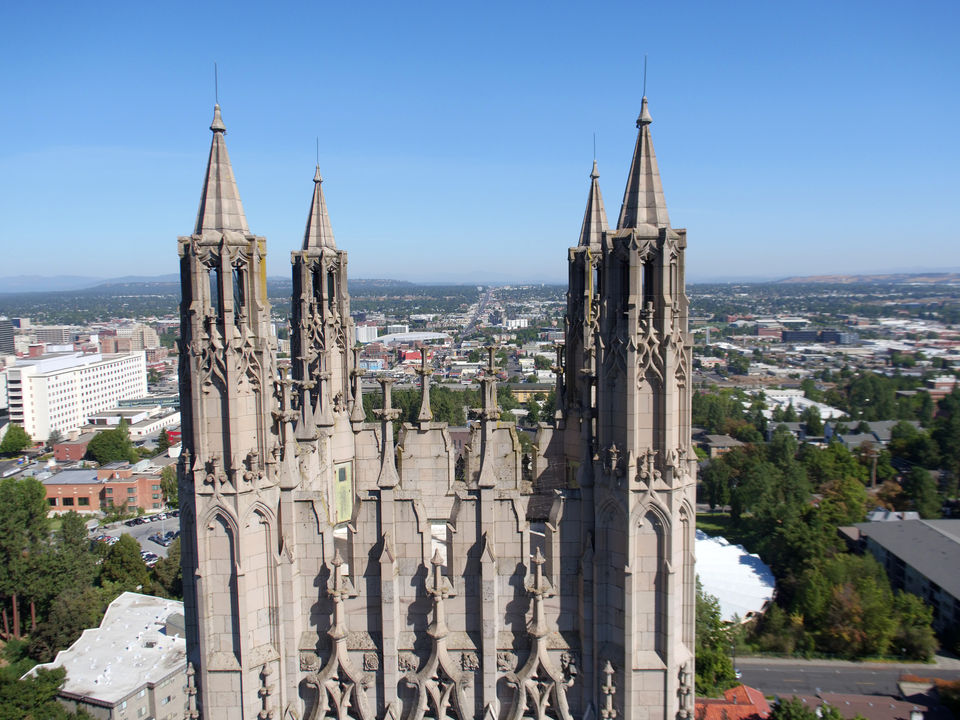The Cathedral of
St. John the Evangelist
How Drone Inspections Save Time, Money, and Ensure Safety for Complex Roofing Projects
Using drone-mounted cameras, our team efficiently inspected 1,232 linear feet of flashing and gutters in just four hours. This approach eliminated the need for costly lifts, minimized labor-intensive processes, and reduced safety risks. During the inspection, the contractor's team watched live footage, requesting closer looks at specific areas of concern. High-resolution images were delivered within two days, providing precise documentation for analysis.
The building posed significant challenges for a traditional inspection:
-
A specialized man-lift was estimated to cost $2,000 per day.
-
The inspection process was expected to take approximately four days, totaling $8,000, not including the cost of a two-person inspection team.
-
The lift needed to extend nearly 200 feet, presenting serious safety risks for the team.
By using drone technology, my team was able to overcome these challenges efficiently. We completed the inspection of 1,232 linear feet of flashing and gutters in about four hours, eliminating the need for costly equipment and labor-intensive processes. Additionally, the contractor’s lead staff was able to watch live footage during the inspection and request closer looks at specific areas of concern.
After the inspection, we delivered high-resolution photographs within two days, providing clear documentation for analysis. The contractor saved significant time, reduced inspection costs, and avoided safety hazards, all while gaining precise, actionable insights into the roof’s condition.
Why Choose Drone Inspections for Your Roofing Needs?
-
Cost-Effective: Eliminates the need for expensive lifts and large inspection teams.
-
Fast Results: Inspections are completed in hours, with processed images delivered in just days
-
Improved Safety: Avoids the risks associated with accessing high or precarious areas manually.
-
Detailed Analysis: High-resolution imagery captures every detail of the inspection area.
When faced with complex projects like inspecting flashing and gutters on a historic building, drone inspections provide a safe, efficient, and cost-effective alternative to traditional methods. Contact us today to learn how drone technology can help protect your investment while saving time and money.
The Cathedral of St. John the Evangelist, located in Spokane, Washington, is an Episcopal cathedral known for its Gothic Revival architecture. Construction began in 1925 and was completed in 1954. The cathedral features a prominent sandstone exterior and a 180-foot tower.
Over the years, the cathedral has undergone various renovations to preserve its structure and enhance its facilities. For instance, a significant exterior rehabilitation was nearing completion in 2022, focusing on masonry repairs, waterproofing, and the installation of new lighting schemes.
One of the benefits of using a drone is the ability to access inaccessible (or just difficult to access) places. In this example, I was called to inspect the flashing where the copper roof is inserted into the sandstone walls. The contractor I worked with was trying to determine the source of water leaking into the building and he suspected the flashing insertion points. There was
also concern about the gutter system.
The problem with building, as you can see, is the difficulty of access to flashing and gutters. The correct man-lift would have cost about $2,000 per day. The contractor estimated it would have taken close to a week to do the inspection. So, for 4 days, that would have been $8,000. That does not include the cost of a 2 person team to do the actual inspection and take photographs of 1,232 linear feet of the areas of concern. Nor does it address the potential safety risks. Remember that the lift would have to extend nearly 200’ for proper access.
With my team, we were able to photograph every foot of the perimeter in about 4 hours. During that time, the contractor was able to have his lead staff watch over my shoulder and ask for particular attention to specific areas of concern. The photographs were presented to the contractor after 2 days processing the images. Time, money and safety were all minimized.





